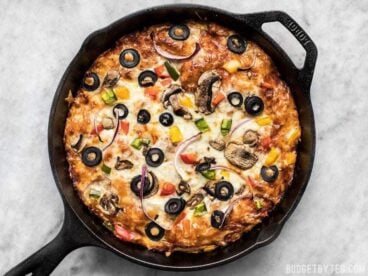
Now love yourself and enjoy this one ...
Sheet Pan Pizza is the solution for anyone hoping to make crave-worthy, restaurant-quality pizza at home—at half the cost of carry-out! Our recipe for Sheet Pan Pizza will level up any casual date night in, make for an unforgettable family dinner, or serve as an interactive party dish where everyone helps pick the toppings. Sheet Pan Pizza is not just for special occasions. It’s also the perfect “take-out fake out” meal for two that will yield enough leftovers to check off some weekly meal prep!

WHAT IS SHEET PAN PIZZA?
This recipe for Sheet Pan Pizza combines my two favorite kinds of take-out pizza. The crust is a sturdy Foccacia bread, typically used for Sicilian-style “Grandma Pie,” that is baked and then covered edge-to-edge with tons of cheese and toppings—sort of like a Detroit-Style pizza—and then baked again! Sheet Pan Pizza is a fun way to feed a crowd and can easily be divided into sections so everyone in the family gets to have a few slices with their favorite sauce and toppings.
WHAT YOU NEED TO MAKE A SHEET PAN PIZZA:
- A SHEET PAN: We suggest using a standard 18” x 13” rimmed metal baking sheet or the 16″ x 12.5″ x 1″ enamelware pan in our Shop.
- PIZZA DOUGH: Our No-Knead Focaccia is oh-so-tasty on its own, but next level as the base of a giant pizza. Totally worth the extra time to make it from scratch! (You can also use store-bought pizza dough—see note below.)
- OLIVE OIL: We used as little olive oil as possible to make this recipe budget-friendly. (Feel free to use a bit more!) You can substitute or mix it with plain cooking oil to reduce costs even more, but the pizza crust will lack the distinctive taste olive oil provides.
- STORE-BOUGHT SAUCE: We chose a store-bought, traditional pizza sauce in order to keep things simple. You can totally make your own homemade pizza sauce! Or swap it out for a jar of alfredo sauce, vodka sauce, prepared pesto, or BBQ sauce!
- TONS OF SHREDDED CHEESE: You need a good amount of cheese for this recipe, but it’s totally worth the extra ingredients to balance out all the bread, sauce, and toppings.
- YOUR FAVORITE PIZZA TOPPINGS: Keep it classic or mix it up—anything goes when it comes to Sheet Pan Pizza!
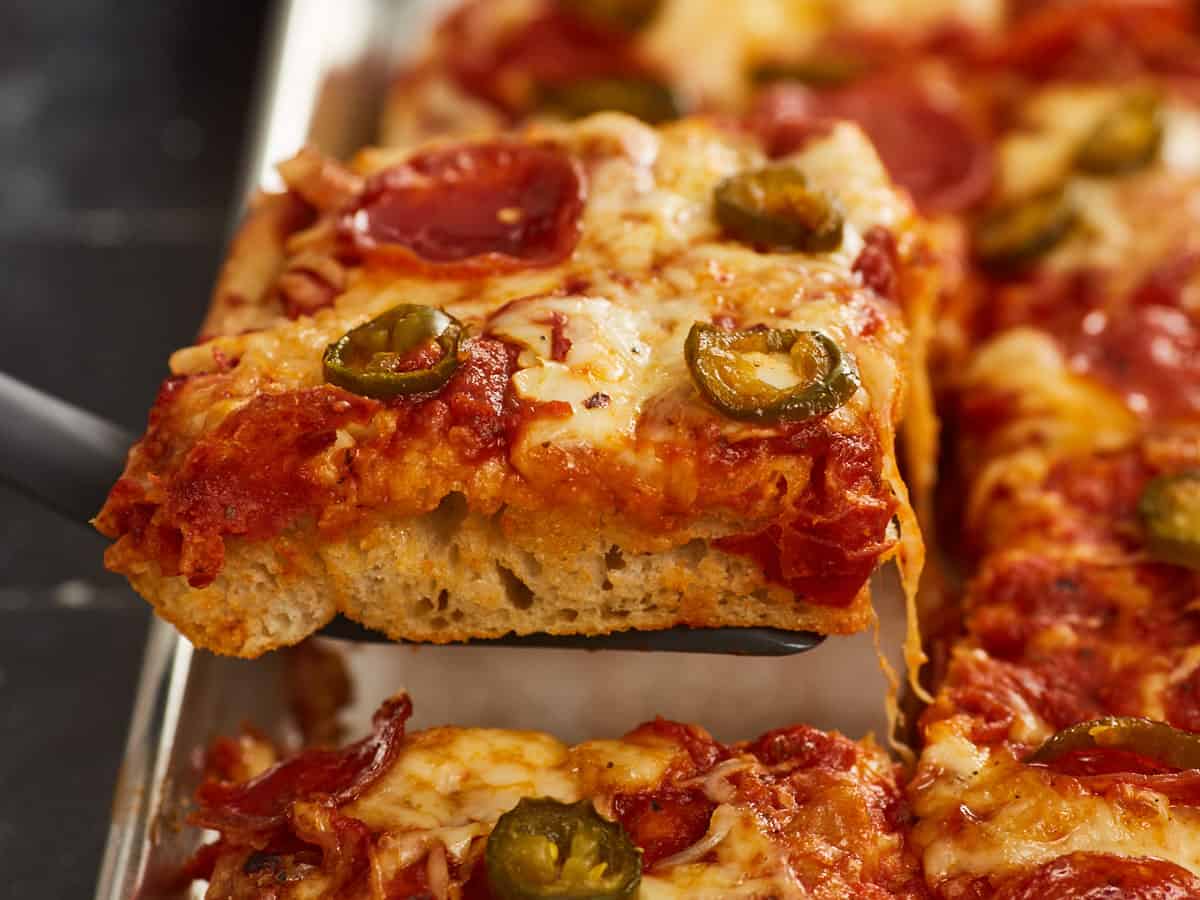
DO I HAVE TO MAKE MY OWN CRUST?
I would highly suggest making the pizza crust in this recipe - our shockingly-easy No-Knead Homemade Focaccia. It pretty much does the work on its own! You can substitute the homemade crust with 1 lb. of store-bought pizza dough for this Sheet Pan Pizza recipe (and start with the second set of instructions on the recipe card), but the results will be slightly different from the pizza we made.
TIP: Making Two Pizzas
- If doubling the recipe: Prepare a doubled amount of pizza dough at once in a very large mixing bowl. Slice the large ball of dough in half (after the first ferment), and transfer each to its own 1/2 sheen pan for the second rise. Follow the recipe as written, also rotating and flipping the baking sheets halfway through both bakes so both pizzas cook evenly.
- Alternatively, when making two smaller pizzas: Slice the risen ball of dough in half and transfer each to its own 1/4 sheet pan for the second rise. Split the remaining ingredients between the pizzas, and reduce both baking times by about 5 minutes each (also relying on the visual cues as a guide to prevent over-baking or under-baking the crust).
MAKE AHEAD & MAKE IT EASIER
- You can make the dough for this Sheet Pan Pizza ahead and store it tightly covered in the fridge for up to 24 hours before baking it. Let it sit out at room temperature for about 30 minutes before transferring it to the sheet pan.
- You can also pre-bake the pizza crust up to 8 hours ahead. Let the bread cool completely before covering it to keep it from getting soggy. When you’re ready to eat, just top the crust with sauce and toppings and bake it again for 10-15 minutes.
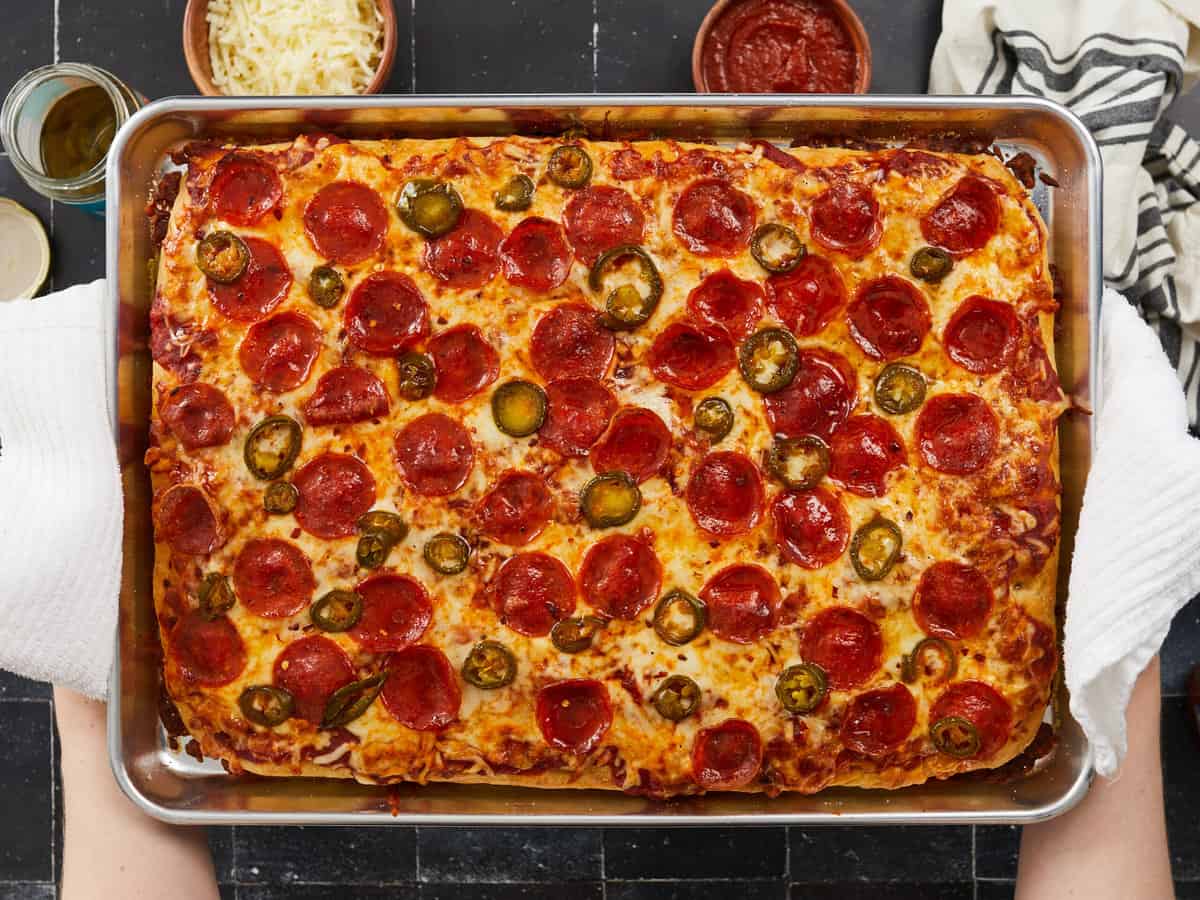

Sheet Pan Pizza
Equipment
- Baking Sheet around 18" x 13" x 1"
- Glass Mixing Bowls
- Pizza Cutter
Ingredients
Crust:
- 4 cups all-purpose flour $0.61
- 2 cups water $0.00
- 1 1/2 tsp salt $0.03
- 2 tsp instant yeast 0.48
- 2 Tbsp cornmeal $0.03
- 1 Tbsp olive oil* $0.15
Pizza:
- 3 Tbsp olive oil, divided* $0.45
- 1/2 tsp salt $0.01
- 1/2 tsp Freshly cracked black pepper $0.02
- 1/2 tsp Italian seasoning $0.05
- 1/2 tsp red pepper flakes $0.05
- 1 14oz. jar pizza sauce $1.59
- 2 cups shredded mozzarella $2.49
- 1/2 cup Parmesan cheese, shredded or grated $0.75
- 1/2 cup pepperoni slices (about 3 oz.) $1.50
- 1/3 cup sliced pickled jalapeños $0.66
- 2 Tbsp honey $0.38
Instructions
Crust:
- In a large mixing bowl, combine the flour, water, salt, and instant yeast. Stir until just combined and no streaks of flour remain.
- Drizzle 1 tablespoon of olive oil around the sides of the bowl, and lift the dough with your hands to make sure the bottom and sides of the bowl are well-coated with the oil.
- Cover the bowl and let the dough rise in a warm, dry place for 2 hours, or in the refrigerator for up to 24 hours. The dough should double in size and appear bubbly, wet, and very fluffy.**
- Coat your fingers with a few drops of olive oil and then scrape the dough from the sides of the bowl, turning it over a few times to form a ball. Rest the dough for 5 minutes.
Pizza:
- Brush 1 tablespoon of olive oil on the bottom and sides of 1 rimmed baking sheet and then sprinkle 2 tablespoons of cornmeal evenly on the bottom of the pan.
- Coat the ball of pizza dough with 1 tablespoon of oil and flip it out of the bowl (oil side down) on the rimmed baking sheet, using a spatula to scrape any oil left in the bowl on top of the dough.
- Gently press down the center of the dough and push it outward toward each corner of the pan. Let the dough rest again, uncovered, until it rises slightly and spreads to fill the sheet pan completely (About 30-45 minutes). While the dough rests, preheat the oven to 425℉.
- Coat your fingers with oil and make dimples all over the dough, also pushing the dough into the corners again if needed. Brush the dough with the remaining 1 tablespoon of olive oil and sprinkle over the salt, fresh-cracked black pepper, Italian seasoning, and red pepper flakes. Bake the crust for 25 minutes, or until the surface of the bread is evenly golden brown.
- Remove the crust from the oven and carefully spread the pizza sauce on top from edge to edge. Then top with the mozzarella cheese, parmesan cheese, pepperoni, pickled jalapenos, and if desired, a pinch of salt, pepper, and other seasonings
- Bake the pizza for another 10-15 minutes or until the cheese has melted and started to brown.
- Remove the pizza from the oven and drizzle the entire surface lightly with honey. Let it cool for 5 minutes and then slice the pizza into 15 squares. Serve each slice topped with more parmesan cheese and fresh-cracked black pepper.
See how we calculate recipe costs here.
Notes
** The dough may need more time to rise in the sheet pan if coming out of a cold refrigerator.
Nutrition
How to Make Sheet Pan pIzza - Step by Step Photos

Combine 4 cups of all-purpose flour, 2 cups of water, 1 ½ teaspoons of salt, and 2 teaspoons of instant yeast in a large bowl. (If using a single-serving packet of yeast, which contains about 2 1/4 teaspoons, you can use the whole thing!) Stir until just combined and no streaks of flour remain. Drizzle 1 tablespoon of olive oil around the sides of the bowl, and lift the dough with your hands to make sure the bottom is also coated. Cover the bowl and let it ferment in a warm, dry place for 2 hours or in the refrigerator for up to 24 hours. (If coming from the fridge, the dough may need an additional 30 minutes of resting time at room temperature.)

After the first ferment, the dough should roughly double in size and appear bubbly, wet, and very fluffy. Scrape the dough off the sides of the bowl with your hands, turning it over a few times to form a ball. Let it rest in the bowl for about 5 minutes to prevent the dough from tearing. Brush the bottom and sides of the sheet pan with 1 tablespoon of olive oil and sprinkle 2 tablespoons of cornmeal evenly on the bottom.
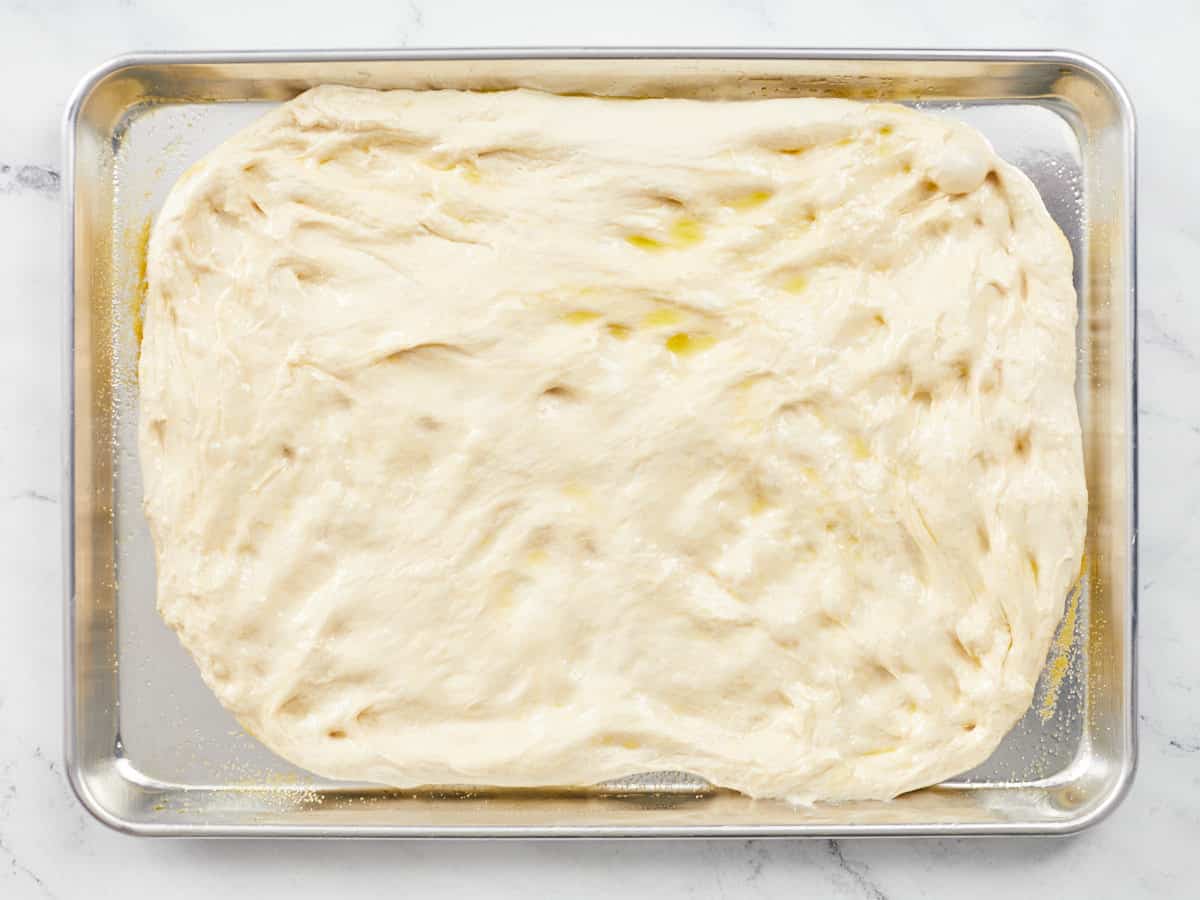
Coat the ball of pizza dough with 1 tablespoon of olive oil and flip it out of the bowl onto the prepared sheet tray (oil side down), using a spatula to scrape any oil left in the bowl on top of the dough. Gently press down the center of the dough and push it outward toward each corner of the pan. Let the dough rest again, uncovered, until it spreads to fill the sheet pan completely (about 30-45 minutes). Preheat the oven to 425℉.
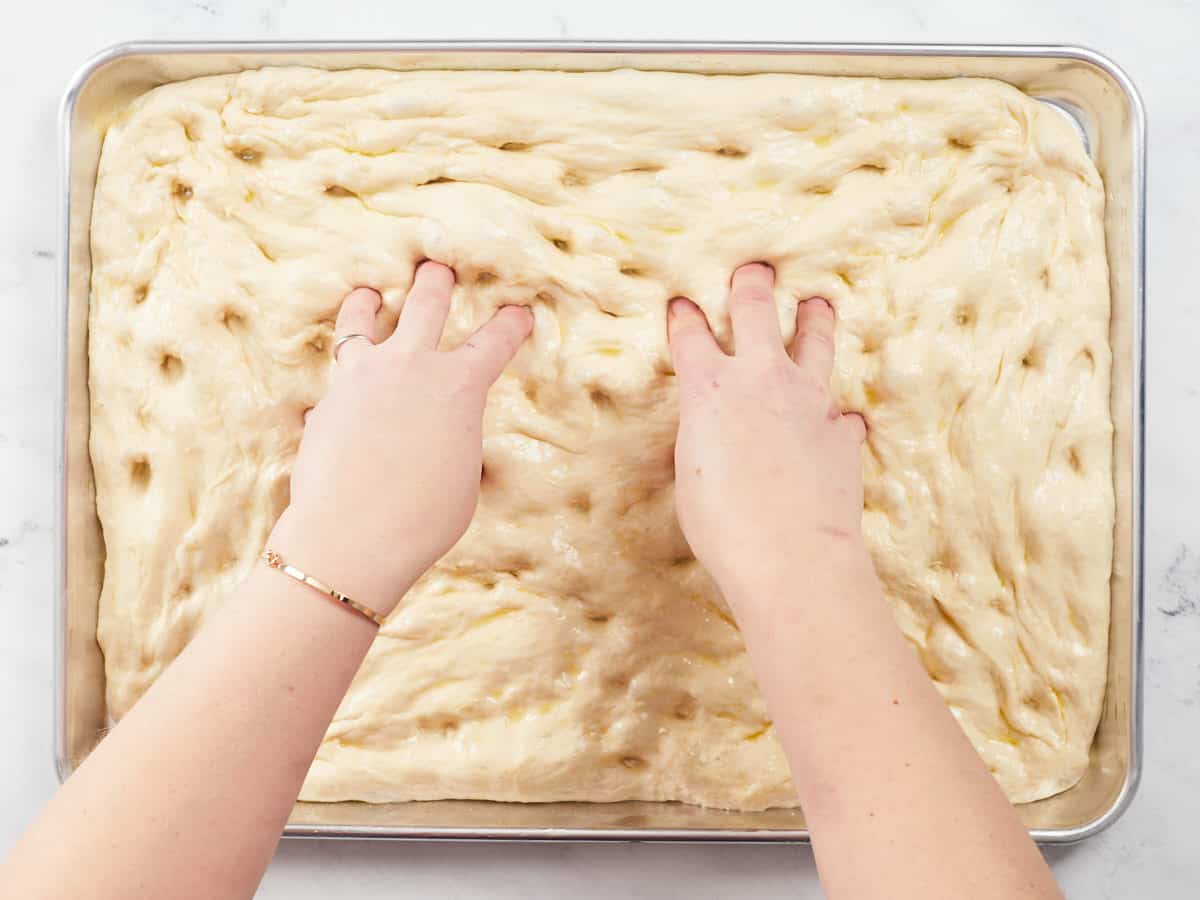
Coat your fingers with oil and make dimples all over the dough, also pushing the dough into the corners again if needed. Brush the dough with the remaining 1 tablespoon of olive oil and sprinkle over a 1/2 teaspoon of salt, 1/2 teaspoon of freshly-cracked black pepper, 1/2 teaspoon of Italian seasoning, and 1/4 teaspoon of red pepper flakes.
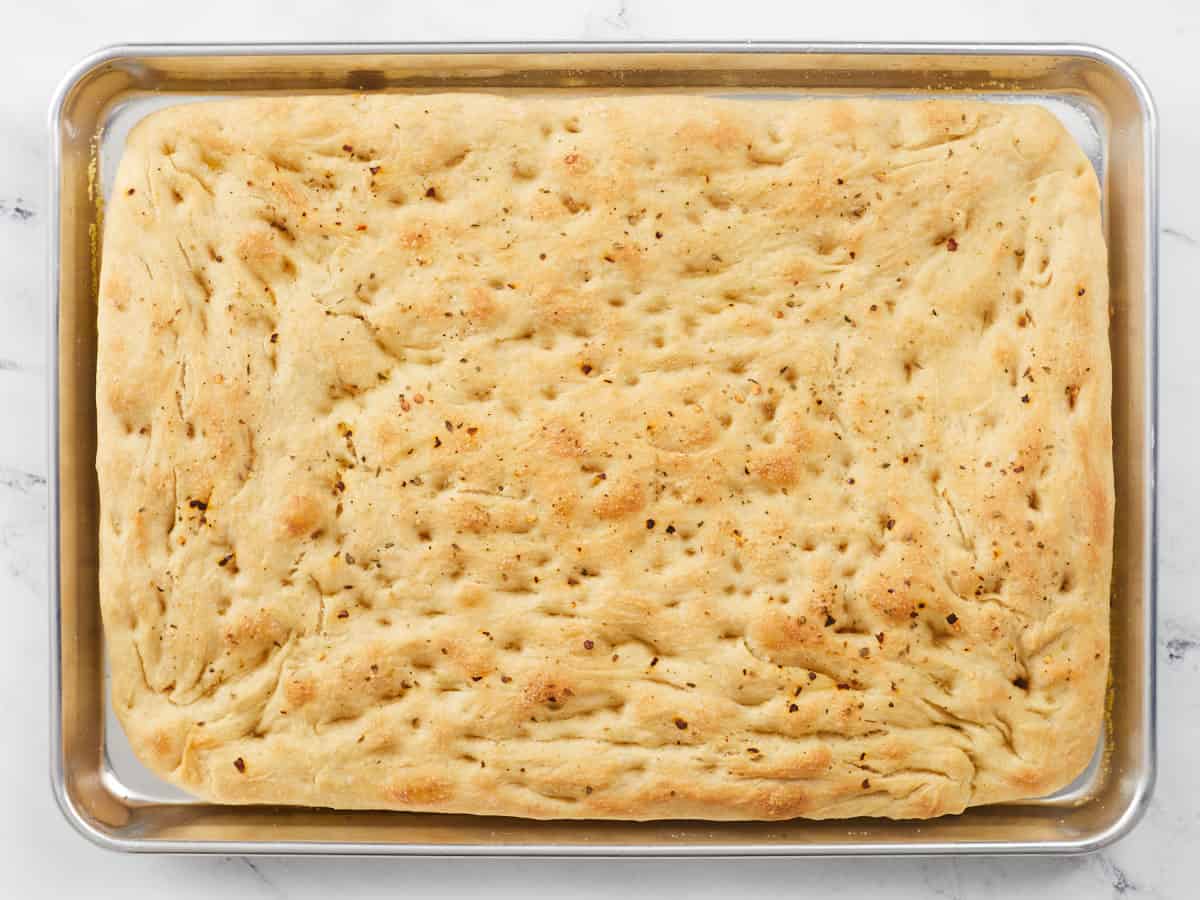
Bake the crust for 25 minutes, or until the surface of the bread is lightly golden brown and has developed a still-tender, but firm crust. When pressed lightly (And carefully, don’t burn yourself!), the center of the crust should spring back and should look and feel fully cooked - not squish and soft.
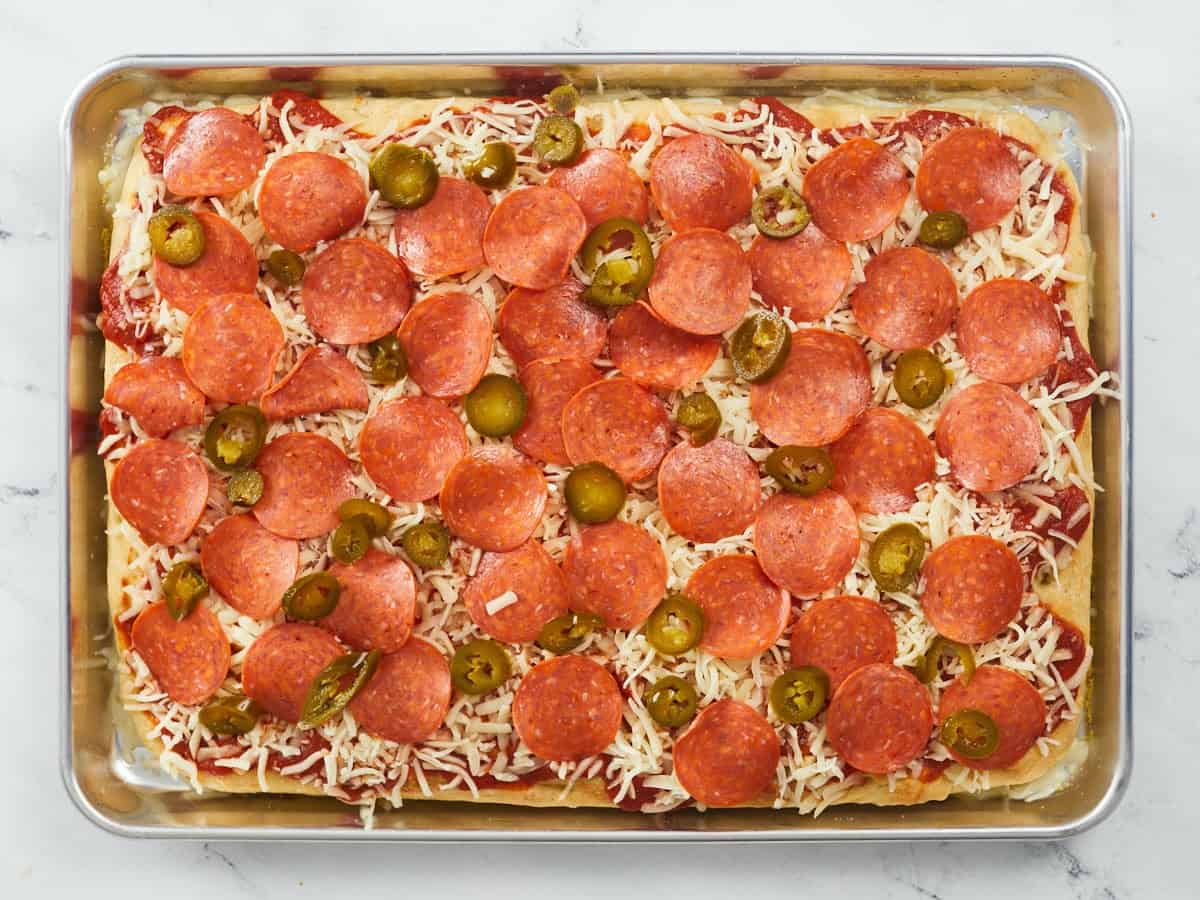
Top the fully-baked pizza crust evenly from edge-to-edge with 1 1/2 cups of prepared pizza sauce (from a 14 oz. jar), 2 cups of shredded mozzarella cheese, 1/2 cup of shredded or grated parmesan cheese, 1/2 cup of pepperoni slices (about 3 oz. or half a standard package), 1/3 cup of pickled jalapenos (about 1/3 of a standard jar), and if desired, another pinch of salt, pepper, and other seasonings.

Bake the pizza for another 10-15 minutes or until the cheese has melted and started to brown. Remove the pizza from the oven and drizzle the entire surface lightly with honey. Let it cool for about 5 minutes (so the toppings don’t slide off), and slice the pizza into 15 squares. Serve each slice topped with more parmesan cheese and fresh-cracked black pepper.
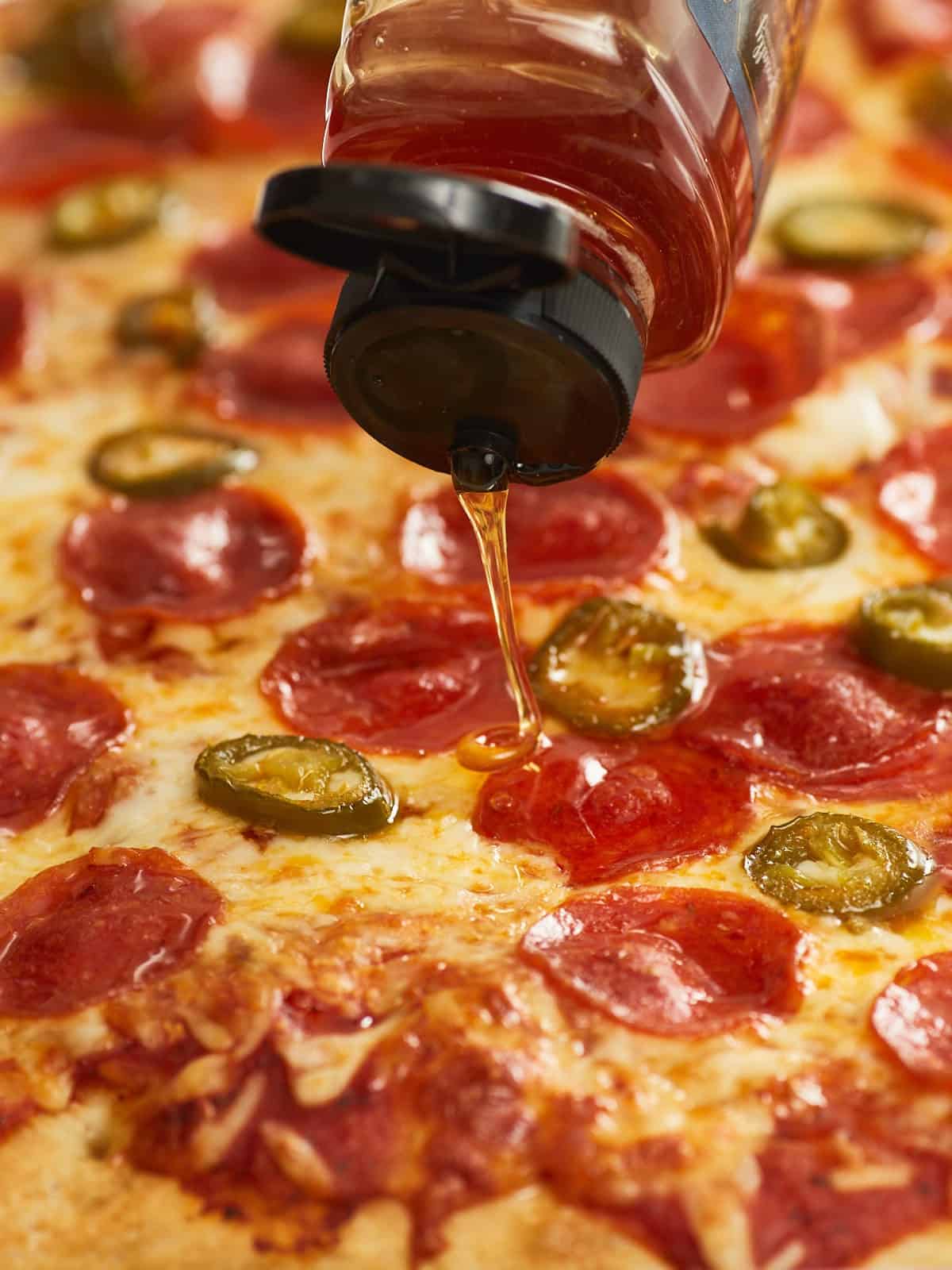
Y’all, I love the combo of sweet & spicy toppings we used in this recipe, but I’m always looking for new ideas for my next Sheet Pan Pizza Party! What sauces and toppings will you put on your Sheet Pan Pizza? Tell us in the comments! ~ Marion :)
MORE DELICIOUS PIZZA RECIPES


Thin and Crispy Pizza Crust

Freezer Ready Mini Pizzas
The post Sheet Pan Pizza appeared first on Budget Bytes.
By: Marion - Budget BytesTitle: Sheet Pan Pizza
Sourced From: www.budgetbytes.com/sheet-pan-pizza/
Published Date: Wed, 15 Feb 2023 18:20:51 +0000
Frequently Asked Questions
How to Store Your Spices?
Keep them in an airtight, dry container away from heat or light.
To store spices for longer periods of time, place them in a dark cupboard. This will preserve them and prevent any oxidation.
Keep spices away from direct sunlight in a dry, cool place. If the spice is placed near a heater or window, it may lose its flavour and aroma.
Spices are best stored in an airtight glass jar or tin. If you are storing your spices in plastic containers, ensure there is no moisture.
It is vital to always check the seal after opening, resealing and before storing.
Don't throw out any spice leftovers. Instead, use them up by adding them to other dishes. To prolong their shelf life you can freeze them.
Almond Flour vs. Almond Meal: What's the Difference?
An almond meal, which can be used as an almond flour substitute, is more versatile than other almond flours because it can be used for baking and cooking, as well as making nut free dishes.
Almond flour can also contain gluten which makes it more difficult to digest. If you have celiac disease or another digestive disorder, it's essential to avoid gluten-free foods.
Almond flour may not be considered a "superfood", per se, but it contains healthy fats as well as fibre, protein and vitamin E.
The nutritional benefits of almond meal include magnesium and copper, iron and zinc, manganese as well as potassium and vitamin C.
Almond flour is made from almonds and contains monounsaturated fat acids. Almond oil, however, contains polyunsaturated oils. Both types reduce LDL (bad) cholesterol and increase HDL ("good") cholesterol.
Almond flour is also rich in antioxidants such as flavonoids and phenolics. These compounds protect against free radical-induced oxidative harm.
An experiment published in the Journal of Agricultural Food Chemistry showed that almond flour has an equivalent antioxidant activity to that of blueberries.
Almond flour is typically sold along with almond milk, which is fortified to add additional nutrients.
What spices are used in Thai cooking?
Thai cuisine is famous for its complex flavor profiles. These flavors are created from unique, flavorful spices which create delicious dishes.
Thai cuisine uses common ingredients such as galangal (lemongrass), kaffir lime leaves and chillies.
Each one of these spices adds to Thai cuisine’s unique flavour profile. It is used often in soups and curries; galangal lends a slightly peppery taste to dishes; chillies add a spicy kick; garlic gives dishes an umami depth; shrimp paste adds a subtle, but fragrant, aroma to dishes; coriander brings out a mild, yet pleasant aroma to dishes; cumin adds a smoky flavor to dishes; and turmeric gives food a vivid yellow color.
These spices create complex flavour profiles that are unique to Thai cuisine. Mixing spices together can make dishes both tasty and aromatic. These spices will help you bring Thailand's flavours to your kitchen.
What's the difference between cooking whole and with ground spices? Ground Spices?
There are no significant differences in the cooking of whole and ground spices. After harvesting, all spices are ground. This ensures that there are no differences in the quality of spices.
However, this price differential is quite significant. Whole spices are more expensive due to the labour required for processing them. But the flavour is well worth it.
You'll often find extra discounts for bulk purchases when you buy whole spices. For example, you might receive a discount if you buy an entire bag of cinnamon sticks.
The same is true for nutmeg cloves ginger, cardamom, and ginger. You may be able save money if you buy these spices in bulk.
Whole spices also last longer than ground spices. Because ground spices lose potency quickly from oxidation, this is why whole spices last longer than ground spices.
Whole spices are a great way to add personality and flavor to your recipe.
You can make delicious curry using whole turmeric, instead of ground turmeric. For chicken dishes, whole coriander seeds can be ground to make a spice blend.
Grinding spices takes time. If you're buying whole spices it makes sense for you to buy large quantities. That way, you won't run out of spices too fast.
Statistics
- According to the McCormick Science Institute, indigenous Indian spices were cultivated as early as the 8th century BC in the gardens of Babylon. (spicecravings.com)
- Their 14 to 20 percent essential oil content means that cloves have the highest concentration of aroma compounds of any spice. (masterclass.com)
- India contributes to 75% of global spice production. (en.wikipedia.org)
External Links
pubmed.ncbi.nlm.nih.gov
doi.org
amazon.com
- Amazon.com. Spend less. Smile more.
- Amazon.com : Morton & Bassett Whole Nutmeg 1.9 Oz : Nutmeg Spices And Herbs : Grocery & Gourmet Food
healthline.com
- Is Pink Himalayan Salt Better Than Regular Salt?
- Turmeric and Curcumin have 10 proven health benefits
How To
How to Cut Shiitake Mushrooms
The shiitakes seem to be doing well. They are fine. But how do we cut them without cutting ourselves? We have tried everything, even using scissors. But they keep slipping out of our hands. What is the deal?
You have a trick. Put a rubber band around your mushroom stem and twist it tight. You won't slip or cut yourself.
You may think it sounds too easy. It is. But it's also very useful.
The rubber band makes stems slippery, making them feel more natural when picked up. Plus, it doesn't hurt to hold the stem tightly.
Do it! You will be amazed at the ease with which you can now cut mushrooms.
Did you miss our previous article...
https://belovedsaffron.com/recipes/rosemary-simple-syrup
.png)





